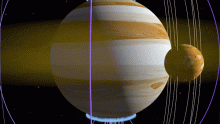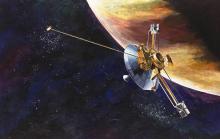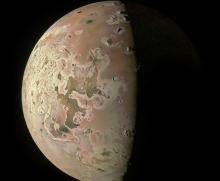Listen to today's episode of StarDate on the web the same day it airs in high-quality streaming audio without any extra ads or announcements. Choose a $8 one-month pass, or listen every day for a year for just $30.
You are here
Jupiter at Opposition II
Every planet in the solar system appears to have a solid core — a dense, heavy ball of rock and metal. But scientists aren’t quite as sure as they used to be about the core of Jupiter, the biggest planet. Observations from an orbiting spacecraft hint that Jupiter’s core could be partially liquid — or the planet might not even have a core at all.
Jupiter probably is made of layers. The outer layer consists mainly of hydrogen and helium — the same elements that make up the Sun. At greater depths, the hydrogen and helium are squeezed more tightly by Jupiter’s gravity, so they eventually form a liquid.
Below that, the pressure is even greater. Electrons are stripped away from the hydrogen atoms, forming a layer of metallic hydrogen. Motions within this layer generate electric currents, which in turn produce Jupiter’s magnetic field.
And at the center of the planet is the core — or at least the spot where the core should be. The Juno spacecraft is measuring Jupiter’s magnetic and gravitational fields. Those readings should tell scientists what’s really there. So far, they’re hinting that perhaps the core has dissolved — leaving Jupiter as the only planet without a solid heart.
Look for Jupiter in the southeast as night falls. It looks like a brilliant star — shining at its brightest for the entire year. It scoots across the south during the night, and sets in the southwest around sunrise.
More about Jupiter tomorrow.
Script by Damond Benningfield





